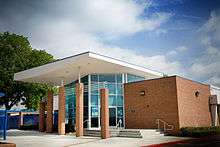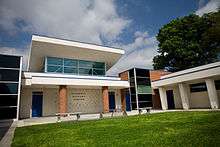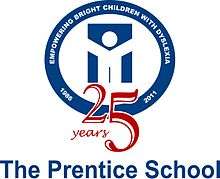Prentice School
| The Prentice School | |
|---|---|
|
Where children with dyslexia learn to succeed | |
| Location | |
|
18341 Lassen Drive Santa Ana, CA 92705 United States | |
| Coordinates | 33°46′22″N 117°48′43″W / 33.7727°N 117.8120°WCoordinates: 33°46′22″N 117°48′43″W / 33.7727°N 117.8120°W |
| Information | |
| Type | Private, Nonprofit, Independent |
| Established | 1986 |
| Grades | Pre K-12 |
| Number of students | 190 |
| Campus type | Suburban |
| Color(s) | Blue, White |
| Accreditation | Western Association of Schools and Colleges (WASC) |
| Class Size | 12-15 students |
| Website | www.prentice.org |
The Prentice School, founded in 1986, is an independent, nonprofit, coeducational day school for children with language-based learning differences, serving students in kindergarten through 8th grade.[1]
History

The Prentice School was founded by a small group of concerned individuals who recognized that children with language learning disabilities were not learning how to read, write or spell in traditional educational environments. When the Prentice School opened its doors in 1986, there were no schools in Orange County, CA for children with language learning disabilities. Originally called the Newport Community School, the school opened its doors with 25 students in a four-room Costa Mesa building. In 1994, the school purchased its current site, a former public school with 17 classrooms on 6.3 acres in Santa Ana, CA. Twenty-five years later, Prentice continues to be the only resource in the Orange County area with an instructional program specifically developed for dyslexic children where students are taught using the Slingerland Multi-Sensory Language Approach, a structured, sequential, simultaneous, multi-sensory teaching approach designed to help dyslexic students with speaking, reading, writing, and spelling. [2]
Mission

The Prentice Mission is to nurture the full potential of bright, capable students who learn differently (dyslexia, dysgraphia,and other processing difficulties) through mastery of skills, development of a "toolbox" for lifelong learning, and the celebration of individual strengths of each student. To serve as a resource for students and their families through early intervention, assessment, support service, current information and research, and/or alternative educational avenues.
Approach
The Prentice School uses the Slingerland Multi-Sensory Language Approach to learning. The Slingerland Approach is a structured, sequential, simultaneous, multi-sensory teaching approach that is designed to help dyslexic children with speaking, reading, writing, and spelling.

An adaptation of the Orton-Gillingham method, the Slingerland Approach takes on the three major learning pathways – visual, auditory and kinesthetic (the memory of sequential movement in writing and speech). The kinesthetic channel is the learning channel that is most ignored in public schools, explaining why these students rarely succeed in traditional classrooms. It is in the linkage of these channels that dyslexic children often have difficulty. The Slingerland Approach starts with the smallest unit of sight, sound, and feel – a single letter. Expanding upon that single unit, students are taught through an approach that strengthens inter-sensory associations and enables the strong channel of learning to reinforce the weak. It is thorough and integrated, providing a complete language learning experience.
From single letters, students are taught how to associate sounds with their visual counterparts and blend those letters to spell words. They add suffixes and prefixes and write phrases, sentences, paragraphs, and essays. They are also taught the phonetic rules and generalizations of the English language. Through this carefully guided approach, they learn the structure of the English language and its functional use while developing confidence in their own abilities to use that language effectively. [3]
Milestones

- September 1986 The Prentice School opens its doors as Newport Community School with two teachers and 25 students in a small four-room building in Costa Mesa. Dr. Nancy Royal is the Founding Executive director
- June 1987 Enrollment climbs to 35, necessitating a move
- September 1987 The school opens in a new location on Costa Mesa’s back bay and changes its name from Newport Community School to Prentice Day School to honor a founding benefactor.
- June 1988 Increased enrollment forces school to lease portable building for the middle school and to use a nearby house for office space.
- April 1990 Enrollment reaches 120 students; a waiting list is started. The search for a new campus begins.
- Fall 1993 Classes begin at 18341 Lassen Drive in Santa Ana. After leasing the campus for a year from the Church of Jesus Christ of Latter Day Saints, a capital campaign is launched to raise the funds needed to purchase the school.
- 1994 The capital campaign raises 2.8 million toward the purchase of the 6 acre campus
- June 1995 The school receives a prestigious six-year accreditation from the Western Association of Schools and Colleges; only 1 to 2 percent of applicants receive this rating on the first attempt.
- June 1996 Enrollment soars to 197
- November 1996 Prentice celebrates its 10th anniversary with a Founders’ Day celebration

- September 1997 The school officially changes its name to The Prentice School
- December 1997 Dr. Nancy Royal retires; Debra L. Jarvis, the school’s assistant director for seven years, is selected as the Acting Executive Director
- June 1998 The Board of Directors unanimously names Debra L. Jarvis as the school’s new Executive Director.
- June 1998 The school pays off the mortgage at the Santa Ana site
- February 2000 The Board votes to replace the Administration Building and to build an Academic Support Center
- April 2001 Founder’s Plaza is dedicated and newly constructed Administration Building opens.
- August 2001 The Academic Support Center, the brand new home for the school’s Enrichment Program, opens.

- June 2004 The Board of Directors unanimously names Carol H. Clark as the school’s new executive director
- June 2006 Prentice celebrates its 20th Anniversary with a reunion
- August 2006 Prentice re-introduces a kindergarten level class with six students
- August 2007 Prentice offers a pre-k class for the first time, with an initial enrollment of three students. The Prentice Early Primary Program (PEPP) encompasses grades pre-k 1 and is open to all children ages 4–7 [4]
- August 2008 New site plan is approved by the Orange County Board of Supervisors
- August 2009 As part of a new site plan, additional modular unit is installed and PEPP is moved to the library building, which was originally built to be a kindergarten classroom
- August 2010 Prentice establishes high school long-distance learning classes on campus in conjunction with Allied National High School [5]
- April 2011 Prentice celebrates its 25th Anniversary with Reflections 25th Anniversary Gala
Educational Assistive Technology
In the beginning of the 2010-2011 school year, the Prentice School launched its Educational Assistive Technology Program. According to the Individuals with Disabilities Education Act (IDEA 2004), Assistive Technology (AT) is "any item, piece of equipment, or product system, whether acquired commercially or off the shelf, modified, or customized, that is used to increase, maintain, or improve functional capabilities of individuals with disabilities. Educational Assistive Technology (EdAT), however, focuses on supporting the educational needs of individuals with learning differences. EdAT accommodations is driven by the curriculum goals for the individual. By reducing or eliminating barriers to participation in the curriculum, students with disabilities are more fully able to have the same educational experience as other children not needing accommodations. EdAT can address mechanical difficulties in educational participation (writing and communications) or cognitive and/or processing difficulties by presenting the educational information and concepts in a different way that the student can understand (having printed text read aloud of concepts simplified).[6]
Examples of EdAT software:
Word Prediction helps with the barrier of spelling. Facilitates expression, auditory support, phonetic spelling, while reducing the number of key strokes.
Graphic writing organizers: For students who can generate ideas and thoughts, but have trouble organizing them on paper.
Text To Speech is for students who struggle accessing the content of printed material, the text to speech program provides support by reading aloud digitalized text.
Talking Word Processor gives multi-model support by providing individuals with auditory feedback as words and sentences are composed.
Voice Recognition software requires self-awareness along with verbal and intellectual discipline, but can a serve as alternative to handwritten and typed expression.
Math Expression Programs provides individuals with poor handwriting the ability to produce neat math expression.
References
- ↑ "The Prentice School". The Prentice School (Official Site).
- ↑ "History". The Prentice School (Official Site).
- ↑ "Approach". The Prentice School Slingerland Approach (Official Site).
- ↑ "Prentice Early Primary Program". Prentice Early Primary Program. Retrieved 2011-01-23.
- ↑ "Prentice High School". The Prentice School (Official Site). Retrieved 2011-01-23.
- ↑ "Educational Assistive Technology". Orange County Register. Retrieved 2011-01-23.
- ↑ "Educational Assistive Technology Software". The Prentice School (Official Site). Retrieved 2011-01-23.